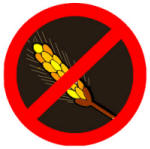|
Jump to:-Â Â
General Advice |Â
Warnings |Â
Gluten Free Foods

Go to:-Â Â
Gluten Free RecipesÂ
|Â Â
Products & Ingredients containing
Gluten |Â
Food and Health
Introduction
Gluten is a protein found in wheat and also in a number of other cereals including oat, rye and barley.
Gluten-free products do not contain gluten, but they may still have other
proteins found in wheat (albumins, globulins and starch granule proteins). So
these might not be suitable for people who are intolerant or allergic to wheat.
It is important to understand that products labelled "wheat free" are not the
same as those labelled "gluten free".
If you have coeliac (celiac) disease you need to avoid foods made from these cereals, including most types of bread, pasta, pizza, pastry and cakes.
Wheat ingredients are used in many foods, such as some sausages and burgers, over the counter ready-to-eat meals and many sauces. Foods in batter or breadcrumbs are not suitable for people with celiac disease either.
If you have coeliac
disease, always check the ingredients on the foods you buy. You will also need
to avoid some alcoholic drinks made from barley, such as beer and lager and some
medications containing starch.
1. Shopping for Gluten Free Foods.
Some foods labelled as 'gluten free' may contain small
amounts of gluten. This is because some of these contain
a special starch that has been treated to reduce the
amount of gluten in it and it's impossible to remove the
gluten entirely. Of course, some foods are naturally
free from gluten, including potatoes, maize and rice.
These are good sources of starchy carbohydrate for
people who need to eat a gluten-free diet. Fruit,
vegetables and unprocessed meat and fish don't contain
gluten, but some processed meats such as sausages and
burgers are made with cereals that contain gluten.
2. Food Labelling.
Since November 2005 food labelling rules require pre-packed foods sold in EU, to show clearly on the label if they (or one of their ingredients) contain any cereal containing gluten � this applies even if the cereal has been specially treated to remove gluten. These new rules should make it easier for you to choose foods that are suitable for you. Bear in mind that there could still be foods on the shelves that were produced before this date.Â
Â
3. Alternative Gluten products.
There are now
many gluten free substitutes available to buy including pasta, bread and
flour which should make cooking favourite recipes easier. You can also make
"home made" substitutes, recipes for which can be found on our Gluten Free
Recipes page.
Â
Â
-
Several types of "alternative" grains often found in breads and other products from health food stores are actually varieties or hybrids of wheat plants. These include teff, spelt, bulgur, couscous, durum, semolina, kamut, and triticale.
Â
|